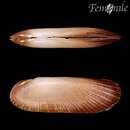en
names in breadcrumbs


“Solemya patagonica, n. sp. (Pl. XI. figs. 1-la).
Testa oblonga, postice paulo angustata, antice sensim latior, arcuatim truncata, epidermide crassa, nigro fusca, radiatim lirata et sulcata, ad marginem prpfunde scissa longeque extra valvas producta, induta. Linea dorsi ante umbones intus incrassata, densatione paulo ante medium aliquanto intra marginem producta. Pagina interna radiatim obsolete subcostata, costa obliqua submediana cæteris majore. Cicatrix postica profunda, oblonga, inferne linea elevata marginem dorsalem anticum versus producta, marginata; cicatrix antica magna, subpyriformis.
Length 31 mm., height 11, diameter 6.
Habjtat.—Station 311, off west coast of South Patagonia, in 245 fathoms.
This is very like other species of the genus in general appearance, but may be recognised by a certain difference of form and other characters within the valves. It is more truncate at the anterior or broader end than any other species with which I am acquainted. It is rather flatter than Solemya parkinsonii, Gray, from which it also differs in having a thickening along the front dorsal edge within the valves, which extends as far as the anterior muscular scar, where it diverges obliquely somewhat from the margin. Another distinguishing feature is the slender lira or raised line which borders the anterior side of the hinder deep scar, and then runs obliquely upwards as far as the middle of the front dorsal thickening. What portion of the ligament may have been internal I am not able to state positively, as only a single specimen was obtained, and that in a dead condition. A part of it may have rested in a slight traversely striated depression, or shallow groove, along the dorsal edge, both in front of and behind the beaks, but I do not think any portion of it was produced within at right, angles to the dorsal margin, as in Solemya parkinsonii and Solemya australis.”
(Smith, 1885: 208-209)